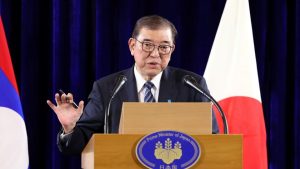On October 1, Ishiba Shigeru became Japan’s prime minister. During the Liberal Democratic Party (LDP) presidential election, Ishiba advocated for the creation of an Asian version of NATO. This attempt by Ishiba may seem sudden, but in reality it is a continuation of Japan’s foreign policy to date. The idea of an Asian version of NATO is linked to two hallmarks of post-war Japanese foreign policy: internationalism and the Japan-U.S. alliance.
Since the conclusion of the San Francisco Peace Treaty and the Japan-U.S. Security Treaty in 1950, Japan’s relationship with the United States has been the cornerstone of Japanese foreign policy. With Article 9 of the Constitution prohibiting Japan from sending troops overseas, Japan has had no choice but to base its foreign policy on its alliance with the U.S.
During the Cold War, Japan provided bases for the United States and cooperated with the U.S.-led international order. Due to the decline in U.S. national power caused by the Vietnam War, the Nixon administration announced the Nixon Doctrine, which called for the division of roles among allied countries. Japan established the Guidelines for Japan-U.S. Defense Cooperation and worked to reduce the burden on the United States in the Japan-U.S. alliance.
After the end of the Cold War, the security environment in East Asia deteriorated as problems linked to North Korea’s nuclear weapons and missiles and China’s military rise became apparent. Amid this, Tokyo strengthened the Japan-U.S. alliance.
Even so, Japan continues to seek a path that complements the Japan-U.S. alliance in the form of internationalism, the idea of seeking common cause with the United Nations and the Asia-Pacific region. The idea of solidarity in the Pacific Rim and the comprehensive security concept proposed by Ohira Masayoshi in the 1970s are positioned in this lineage.
After the end of the Cold War, a turning point came in the Japan-U.S. security relationship. In Japan, too, there was a movement to review the Cold War system. For example, the idea of a U.N. standby force proposed by Ozawa Ichiro, who was secretary-general of the LDP in 1990, was a typical example.
Ozawa argued that Japan should play a role in the formation of the international order after the end of the Cold War. As an economic superpower, Japan has a responsibility to maintain the international order. However, Article 9 of the Japanese Constitution prohibits Japan from sending troops overseas. Therefore, Ozawa proposed that Japan should try to maintain international order through the United Nations. He thought that by participating in U.N. forces, Japan could deploy its Self-Defense Forces overseas. Although Ozawa’s idea did not come to fruition, Japan has continued to participate in U.N. peacekeeping operations based on the idea of cooperating with the United Nations to maintain international order.
At the same time, Japan considered the world after the end of the Cold War to be multipolar, and sought a new order. The so-called Higuchi Report, “The Nature of Japan’s Security and Defense Capabilities,” issued in 1994, stated that in the post-Cold War era, Japan should seek a regional order while maintaining the Japan-U.S. alliance as its cornerstone.
After the end of the Cold War, there was a flurry of activity in the East and Southeast Asian regions to create regional organizations. The ASEAN Regional Forum is one prominent example. After the end of the Cold War, as new threats such as regional conflicts and terrorism became apparent, cooperation in regional organizations was promoted. These efforts have been carried on in the Free and Open Indo-Pacific Strategy announced by the Abe administration.
So does this mean that Japan’s internationalism implies a break with the United States?
Washington has shown its wariness of internationalism, and sees these developments as Japan going its own way. However, internationalism has always been a complement to the Japan-U.S. alliance.
Japan has always based its foreign policy on its alliance with the United States, and the internationalist line was intended to complement the same. Internationalism can be said to be a means of reducing the burden of the Japan-U.S. alliance in the Asia-Pacific region.
The Asian version of NATO proposed by Ishiba can also be positioned in this lineage. While Ishiba is aiming for an equal Japan-U.S. alliance, he has not said that he wants to abandon the alliance. On the other hand, it is an important issue for Japan whether the United States will continue to be involved in the Asia-Pacific region. The Asian version of NATO proposed by Ishiba can be said to be part of Japan’s burden reduction measures to keep the U.S. involved in the Asia-Pacific region.

































